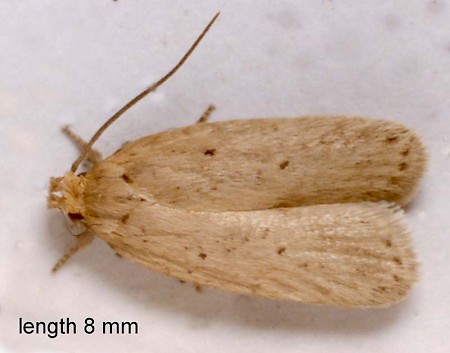
32.023 BF716
Agonopterix rotundella
(Douglas, 1846)
Wingspan c. 15 mm. A relatively uniform-looking Agonopterix, with buffish forewings broken by two or three black dots and occasional scattered blackish scales. The specific name rotundella refers to the rather rounded termen of the forewing.
The adult lives from September to May, overwintering among low vegetation. It will come to light positioned near its habitat.
The larva feeds, June to August, on Wild carrot (Daucus carota), from a thickly folded leaf sewn with white silk. It appears to prefer short plants in full sun on coastal downs and cliffs in England, Wales, southern Scotland and Ireland. Recorded inland in the past, it now appears to be confined to coasts.
- Larva: (description Ian F. Smith):
Foodplant: June - August on Daucus carota. Larval habitation is a thickly folded leaf, sewn with white silk, which often shows between the edges. In a three hour search, twelve larvae were found on short plants on a Cheshire cliff, but none on tall plants 100 metres distant inland.
Intermediate instar
Length: 9 mm described
Head: Black.
Prothorax (T1): Integument reddish. Large black spiracle. Prothoracic shield black.
Thoracic legs: Femur, tibia and tarsus black with white joints. Base as venter.
Body: Dull yellowish green. No obvious lines.
Spiracles: Small. Black.
Pinacula: Small black pinpoints.
Anal plate: Yellowish, translucent.
Prolegs: Yellowish.
Late instar
Length: 12 mm described (reported maximum size; MBGBI)
Head: Black.
Prothoracic shield: Translucent, stained rusty red, obscurely showing green of body below. Divided by thin transparent medial line, showing green clearly. Lateral and posterior margin has a bold wide black 'L' shaped border.
Thoracic legs: Femur, tibia and tarsus brown (MBGBI; yellowish green). Base yellowish.
Body: Apple green. Dorsal line and dorsolateral line dark greyish green.
Spiracles: Small. Black.
Pinacula: Small black pinpoints.
Setae: Brown translucent.
Anal plate: Green as body, with some darker staining.
Prolegs: Yellowish, basally green. Crochets reddish.
Similar species
On Daucus carota.
Agonopterix ciliella is very similar to A. rotundella at both intermediate and late instars. When photographs are compared, the pinacula on A. ciliella look like pinheads, while on A. rotundella they are like pinpoints.
An 11 or 12 mm specimen will probably have intermediate instar colouring if A. ciliella, but late instar colouring if A. rotundella. Specimens of 13 mm or more will probably be A. ciliella as 12 mm is reported to be the maximum length of A. rotundella.
On late instar larvae, the prothoracic plate is black laterally on A. ciliella, but black laterally and posteriorly on A. rotundella.

 UKMoths
UKMoths 




